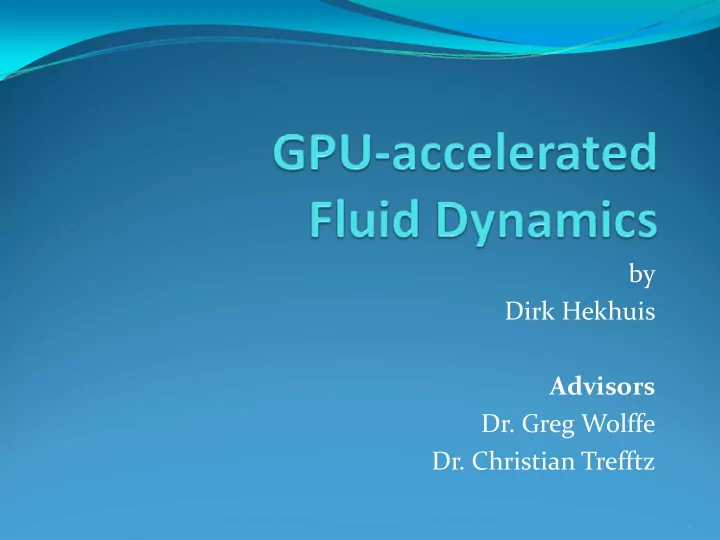

by Dirk Hekhuis Advisors Dr. Greg Wolffe Dr. Christian Trefftz
Applications � Computational Fluid Dynamics have many applications � Automotive Aerodynamics � Designing HVAC Systems � Water Flow Around Submarines � Modeling Dams
The Physics of Fluids Navier ‐ Stokes equations for incompressible flow � Equation for velocity in a compact vector notation � � Equation for density moving through the velocity field �
Fluid Representation
Implementing Navier ‐ Stokes � External Forces � Diffusion � Advection � Projection
External Forces � External forces applied to the fluid can be either local forces or body forces � Local forces are applied to a specific region of the fluid – for example the force of a fan blowing air � Body forces are forces that apply evenly to the entire fluid, like gravity
Diffusion
Advection
Projection
Why use CUDA? 1.1 1.021 1 0.9 0.7737 0.8 0.7 Seconds 0.6 CPU 0.5 GPU 0.4 0.3 0.2 0.0711 0.0693 0.1 0.0155 0.0101 0 Diffuse Advect Project
CPU vs GPU � CPU � Fast caches � Branching adaptability � High performance � GPU � Multiple ALUs � Fast onboard memory � High throughput on parallel tasks � Executes program on each fragment/vertex � CPUs are great for task parallelism � GPUs are great for data parallelism
CPU vs GPU ‐ Hardware � More transistors devoted to data processing
What is CUDA? � Compute Unified Device Architecture � NVIDIA’s software architecture for developing and running data ‐ parallel programs � Programmed in an extension to the C language
Programming CUDA � Kernel Functions � A kernel function is code that runs on the GPU � The code is downloaded and executed simultaneously on all stream processors on the GPU � SIMD Model � SIMD stands for Single Instruction, Multiple Data � SIMD exploits data level parallelism by performing the same operation on multiple pieces of data at the same time � Example: Performing addition on 128 numbers at once
Fluid Dynamics on the GPU � To implement the Navier ‐ Stokes equations on a GPU we need to write kernel functions for: � External Forces � Diffusion � Advection � Projection
Demonstration
Acknowledgements � “Real ‐ Time Fluid Dynamics for Games” by Jos Stam � “Fast Fluid Dynamics Simulation on the GPU” by Mark J. Harris � NVIDIA � developer.nvidia.com/CUDA � “CUDA: Introduction” by Christian Trefftz / Greg Wolffe Grand Valley State University
Recommend
More recommend